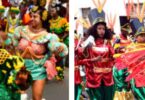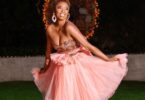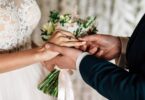When it was Kenyan Deputy President William Ruto’s time to host his soon to be in-laws from West Africa, there was one clear statement; ceremonial Nigerian fashion crowned the dowry ceremony.
Born a Kalenjin, Ruto’s daughter, June Ruto over the weekend finally brought home her choice for the start of the traditional dowry proceedings known as “koito” in the Kalenjin dialect.
At their posh Karen residence, Ruto’s in-law trooped in numbers and here, the conspicuous Nigerian Ankara made a show as Nigerian women who part of the delegation stepped out in beautiful African-designed dresses.
The bride, Dr Alexander Ezenagu wore a long, dazzling white robe, so did his entourage which wore the classic “oga” attire complete with a hat. The hat was a creation of the Yoruba men and spread to the Igbo tribe and is not a national affair as much as it is a cultural affair.

June Ruto with her bridegroom. [Photo: Zonka]
Also read: The Dashiki Fashion For Yoruba Culture In Nigeria
Rachel Ruto together with her daughter June was not left behind either, they stepped out in beautiful Ankara dresses that was the talk among fashion enthusiasts in Kenya. The print design was the same, lengthy, well-tailored and outstanding. The bride’s entourage had beautifully designed all-white wear.
In the African culture, fashion is a big thing during traditional ceremonies which precede marriage. The union of a man and a woman is respected. When a man finds his better half, he makes his intention known to his in-laws-to-be in a series of traditional ceremonies.
The woman also takes her husband-to-be to her parents and introduces him. These celebrations are meant to tap blessings from both parents and bless the union. It is a ceremony that cannot be skipped going by the dictates of the African culture.
While times have evolved, dowry ceremonies are dotted by a set of demands which a man must meet to be allowed to marry his woman of choice. Elders preside over dowry negotiations and ask for goats, cows sheep e.t.c among other things. In some African communities, the animals are presented alive while in others, they are paid for in monetary terms.

Deputy President William Ruto with his wife Rachel and daughter June. [Photo: Lemiso]
Yoruba Traditional Dressing
The Yoruba tribe live in South Western and North-Central Nigeria. They are the majority in Lagos, Oyo, Ekiti, Osun, Oguna and Kwara states. Their signature fashion statement is ‘Agbada’ – a huge type of cloth worn like a jacket and some wear it like a wrapper. ‘Aso-Oke, Ankara, Buba and Igele’ are also popular among the Yoruba tribe.
Also read: 5 Nigerian Fashion Designers Who Have Dressed International Celebrities
Weddings are a great celebration in every culture, so people use all their imagination to create a beautiful and bright wedding dress. Yoruba traditional wedding dress is featured by vivid colours, embroidery and ornamentation. Here you can see how the wedding clothes of a bride and a groom perfectly fit each other.

Deputy President William Ruto Nigerian in-laws. [Photo: The Doyen]
The dressing is common during the Edo wedding attire worn by brides during their traditional wedding ceremony is so rich and regal. They look like true African queens in their beaded coral attires.








